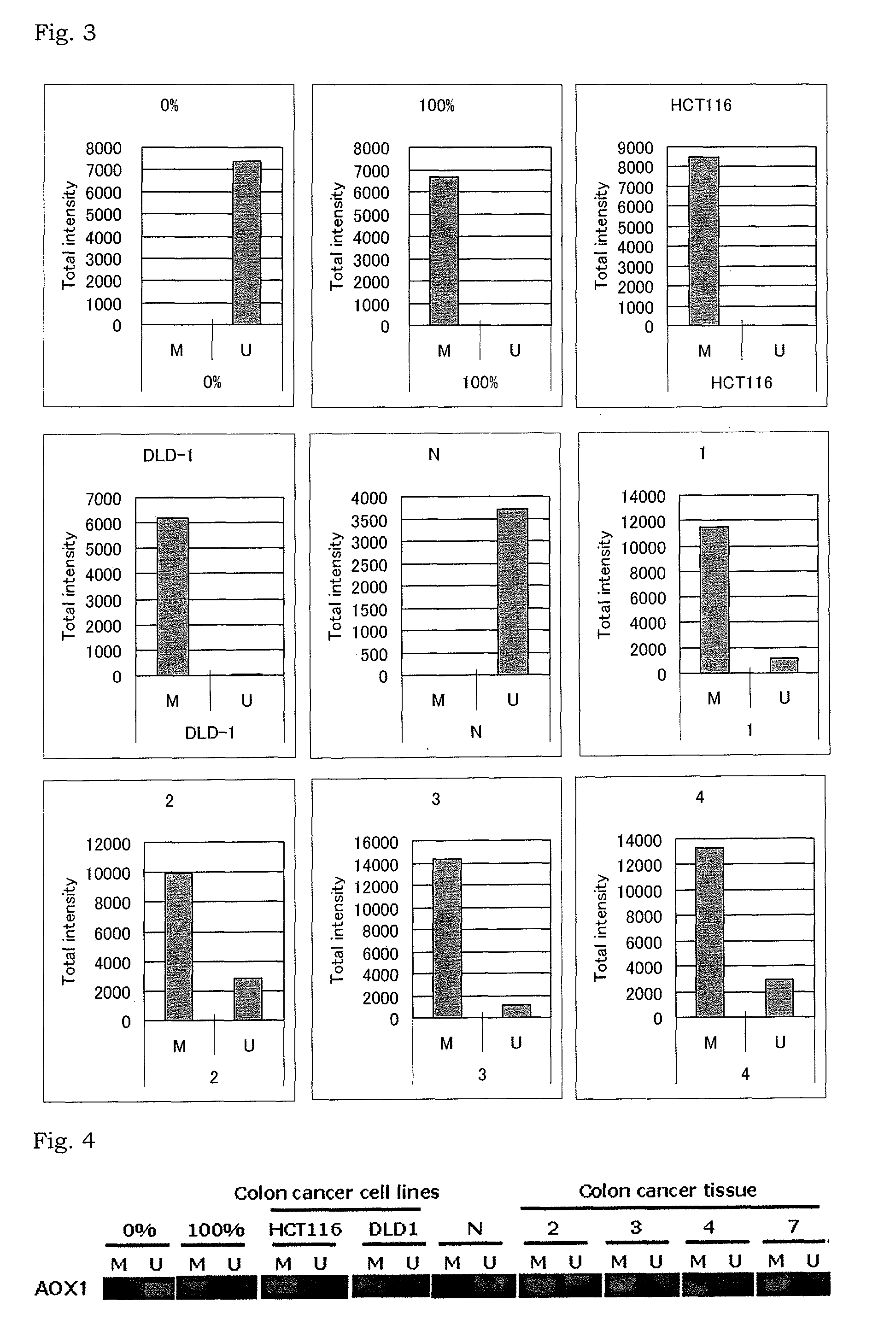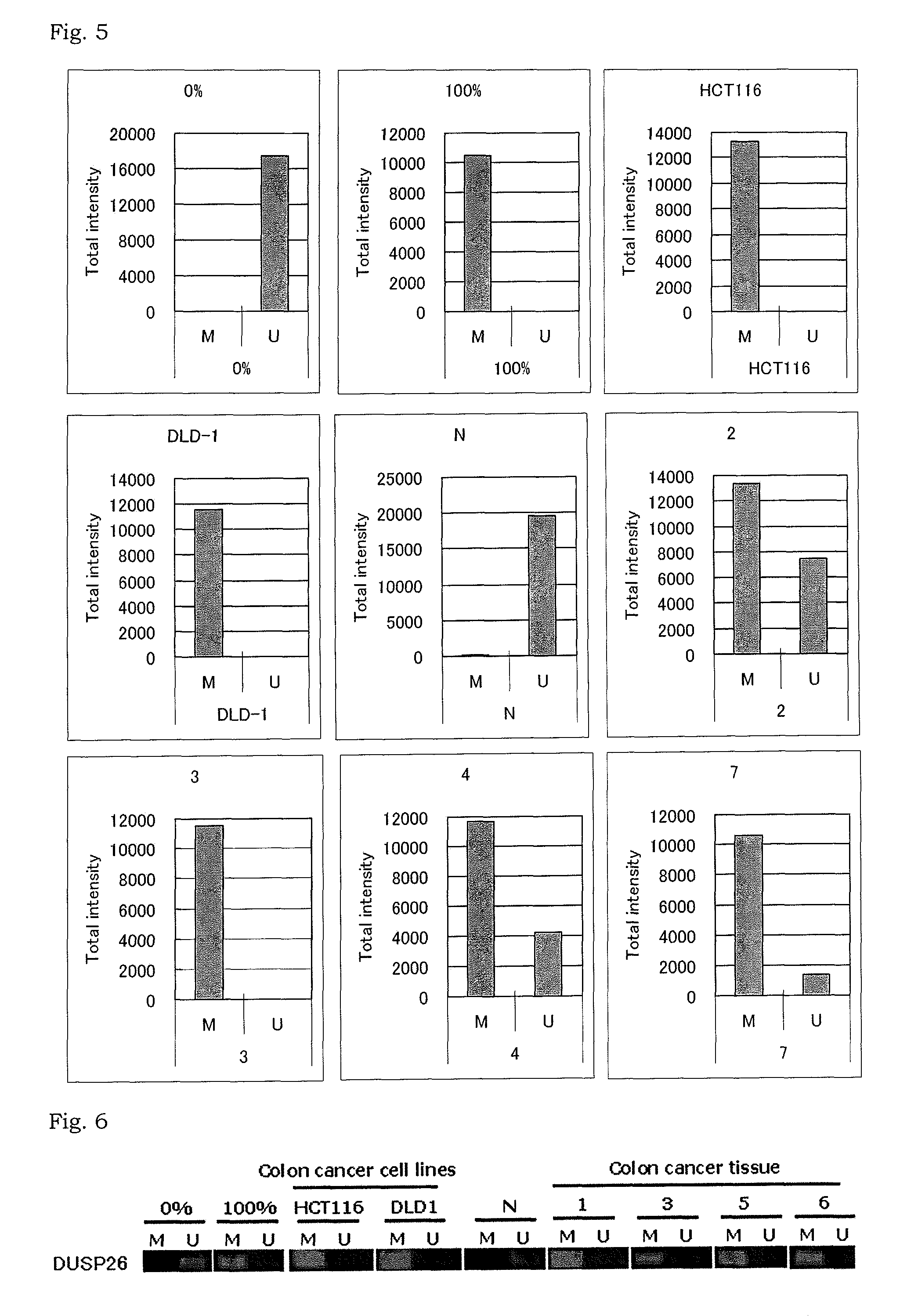Methylation analysis to determine the presence of cancer cells
a technology of methylation analysis and cancer cells, applied in the direction of instrumentation, library member identification, organic chemistry, etc., can solve the problems of difficult colorectal cancer prognosis determination and inaccurate prognosis determination
- Summary
- Abstract
- Description
- Claims
- Application Information
AI Technical Summary
Benefits of technology
Problems solved by technology
Method used
Image
Examples
example 1
Investigation for Marker Gene Candidates by MeDIP-Chip
[0109]The present inventors thought that methylated CpG sites located within 1 kb upstream and downstream of a transcription initiation site of genes are important for gene expression and that genes having a candidate methylation site (CMS) in such region may be possible markers. Thus, they investigated for such genes from a colorectal cancer cell line HCT116 by MeDIP-chip technique.
[0110]The specific procedures in Example 1 followed the instructions attached to the kits and reagents and the description by Hayashi H. et al., Hum Genet., vol. 120, 701-711 (2007).
(1) MeDIP Procedure
[0111]Genomic DNA was extracted from the colorectal cancer cell line HCT116 by using QIAAMP® DNA Micro kit (QIAGEN) according to the attached instruction. The obtained genomic DNA (6 μg) was processed in an ultrasonicator UD-201 (Tomy Seiko Co., Ltd.) for 20 seconds to fragment the genomic DNA to the size of 200 to 800 bp. The DNA fragments were denature...
example 2
Investigation for Marker Gene Candidates by MassARRAY® Analysis
[0146]The present inventors randomly selected 41 genes from 2410 genes obtained in Example 1 as marker gene candidates. Methylation status of the marker gene candidates in colorectal cancer tissues and normal colonic mucosa tissues was analyzed by MassARRAY® analysis (hereinafter also referred to as “mass spectrometry”).
[0147]The 41 marker gene candidates are shown in Table 2.
[0148]The specific procedures in Example 2 followed the instructions attached to the kits and reagents and the description by Ehrich M. et al., Proc Natl Acad Sci USA, vol. 102, 15785-15790 (2005) and Coolen M W. et al., Nucleic Acids Res, vol. 35, 119 (2007).
[0149]
TABLE 2GeneNosymbolGene title1ABTB2ankyrin repeat and BTB(POZ) domain containing 22ADAMTS1ADAM metallopeptidase with thrombospondin type 1motif, 13AOX1aldehyde oxidase 14CDO1cysteine dioxygenese, type15CHFRcheckpoint with forkhead and ring finger domains6CIDEBcell death-inducing DEFA-like...
example 3
Analysis of Correlation Between Methylation of Marker Genes and MSI
[0190]There are many published documents which report on the correlation between MSI and the prognosis of colorectal cancer patients. Generally, it is believed that the cases having high MSI correlate to a favorable prognosis. According to the report by Popat S. et al. (J Clin Oncol, Vol. 23, 609-613 (2005)) who summarized the previously reported data from 32 reports (total 7642 cases among which MSI cases were 1277), it has been understood that the colorectal cancer patients having high MSI have a statistically significant favorable prognosis.
[0191]Accordingly, the present inventors investigated a possible correlation between the proportion of methylation-positive specimens for a marker gene among the above 41 marker genes and MSI.
[0192](1) Determination for MSI
[0193]In order to analyze MSI of genomic DNA of colorectal cancer tissues (112 specimens) obtained in Example 2 (1) (i), sequencing analysis was carried out ...
PUM
| Property | Measurement | Unit |
|---|---|---|
| mass | aaaaa | aaaaa |
| mass | aaaaa | aaaaa |
| pH | aaaaa | aaaaa |
Abstract
Description
Claims
Application Information
 Login to View More
Login to View More - R&D
- Intellectual Property
- Life Sciences
- Materials
- Tech Scout
- Unparalleled Data Quality
- Higher Quality Content
- 60% Fewer Hallucinations
Browse by: Latest US Patents, China's latest patents, Technical Efficacy Thesaurus, Application Domain, Technology Topic, Popular Technical Reports.
© 2025 PatSnap. All rights reserved.Legal|Privacy policy|Modern Slavery Act Transparency Statement|Sitemap|About US| Contact US: help@patsnap.com



